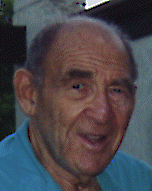Homeokinetics
|
|
founder of Homeokinetics |
|
June 12, 1918 - December 8, 2002 |
Synopsis of background:
Dr. Arthur S. Iberall was a researcher at University of California at Irvine and had a background of 50 year experience in research and development. Trained at CCNY and George Washington University, he is a Fellow of the American Society of Mechanical Engineers and is a Distinguished Annual Lecturer Biomedical Engineering Society. Dr. Iberall received an honorary Doctor of Science degree from Ohio State in recognition of his impressive achievements in interdisciplinary scientific research. Dr. Iberall has been a consultant to the Army, NASA, Department of Transportation, Army Research Office, Navy, and Air Force, and has worked at the National Bureau of Standards and the ARO Equipment Corp. His applied research has ranged broadly in measurement, mechanical instrumentation, high altitude research, hydrodynamic studies of flow fields, nonlinear fluid dynamics, arterial blood flow, the physics of turbulence, high speed electric power switching, and low loss cryogenics.
Dr. Iberall was chief physicist at Rand Development Corp for 10 years, doing applied physical sciences for government and industry. His research has led to material develepment for mobile space suits, development of the first high speed turbine dental drilling, breathing regulators, a nonlinear theory for slack diaphragm design, high strength-high temperature material development, in a general theory for elastically reliable materials, and resolving how to rapidly 'cut' fiberglass and still permit long and cheap tool life, in space suit development. He continued this work as chief scientist and President of General Technical Services, Inc. where his research for major home appliance companies led to the high speed home surface burner, thermal shock resistent refractories, electric sensing and control of heating cycles, the electric knife, topologically programmed fancy sewing stitching, and programmed home food preparation. Importantly, biophysical research for the NASA exobiology program into the dynamics of mammalian physiological processes led to his development of Homeokinesis with Dr. Warren McCulloch. In 1981, Dr. Iberall was invited to the Crump Institute for Medical Engineering of UCLA, where he further refined the key concepts of Homeokinesis, developing a physical scientific foundation for complex systems' systems of nature, life, Man, mind, and society.
As an invited visiting scholar at UCLA, Dr. Iberall became involved in defining the physics and nonlinear mathematics of complex physical systems such as living and social systems, in showing how information flow occurs in complex systems. Courses he has given include the thermodynamics of living systems for chemical engineering students in their thermdynamic study, a two year seminar on the general physical science underlying all complex systems in nature for graduate students, faculty, and non academic well educated professionals, a physical foundation for comparative political systems, and physical foundations for social systems, sponsered by the Marshak colloquium, as a contrast, which commonly gives its honors course as mathematics adaptible to the social sciences.
Dr. Iberall's work continues with the development of a group of social scientists from 5 academic institutions in a physically unified social science. He identifies himself as a generalist, a broad vertical reductionist, who has both read and involved himself widely in many disciplines, and who practices his skills as a applied physicist-engineer in these very many fields. His publications and reports amount to a hundreds of titles.
On Homeokinetics:
"Normal physics deals with processes at single levels -- cosmological physics, stellar physics, and the like -- and also with the relation between systems and their lower levels, but only when the lower level atomisms are simple enough.
"At some levels, systems are found involving very extended time scales among their atomistic processes. It is such levels that we consider to be complex in nature. They have extensive field memory functions; they use languages; they appear to direct their activities almost with purpose. We do not accepts any mystification of their internal actions. We prefer to consider their interiors to be complex factories, and to involve complex factory day processes.
"As a catch phrase, we refer to these systems as nature, life, humankind, mind, and society. Thus biophysics, geophysics, social physics, ecological physics, evolutionary physics, and the like. In common with their simpler counterparts, complex systems exhibit rest phases, smooth or creeping flows, turbulence, and chaotic phases; they alternate in storminess and placidity, and in their intermittence and changeability. It is the hierarchical character of such systems, with both side-side and in-out component processes, that interest us."
